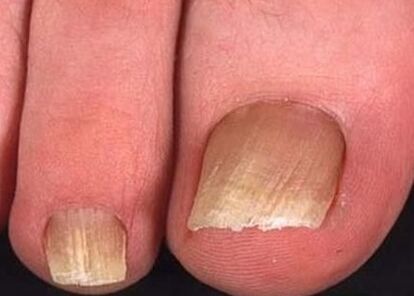
Healthy nails should look good - keep them smooth and even.It should be beige or slightly pink in color, due to the presence of blood vessels below.When defects occur, the nails may lose their normal color, turn black or be painted in a different color.As the thickness changes, the nails become untidy and look sloppy.In some diseases, the nail plate can deform to disappear.
Developmental deformities can be either congenital or acquired.In the first case, this is due to damage to the ectoderm of the nail.After the child is born, it looks like a nail or its absence deformation.
The bad habit of being acquired can develop for a variety of reasons.The most common problem is a fungus, and every third person exists in one form or another.The fungus can not only be external, where only the plates are affected, but also internally - the fabric of the fingers may be affected by its subsequent damage.
Additionally, these diseases may lead to step-step deformation:
- Psoriasis - Due to this pathology, the thickness of the nails has changed.It becomes thicker than usual and becomes unpleasant to touch.Additionally, the pain develops - when palpation occurs, it will feel uncomfortable.Multicolored spots form under the plate - from red to purple - which indicates bleeding.When the infection connects, hematoma under the nails can be observed.Local disengagement from the skin can be observed - forming cavity in these places, making their hands look untidy.Further development of the disease may lead to solute resolution.
- Eczema is often accompanied not only by local failure, but also with a broad sense.That is to say, in addition to damaging the plate, skin symptoms can also be observed.Eczema is manifested by changes in nail rollers and plates.The fabric of the fingers swells and peels will develop.Itching and injury to the affected surface.At the same time, the nails become dull and pale, and their layering or brittleness is possible.
In addition to these reasons, deformation can be caused by fungal infections in the nail plate.
Fungi is a careless attitude that can lead to complete destruction of the plate.In the initial stage, this manifests only as changes in color and thickening, and finally, failure leads to loss of the nail plate.
Signs of fungal infection

When infected with a spinal disease, there is no serious acute pain and disability – so people are often reluctant to notice it.In addition, bacteria did not show any expression changes in the nail plate in the early stages, and it was difficult to distinguish.
First, itching in the skin of the feet appears.It is intense and can be distracted from work or rest.It is caused by the transmission of microorganisms in the dermis, which are regarded as stimulation by the human body.With the ongoing itching, a person may be disturbed by sleep and appetite.When grooming the skin, bacteria may be carried into microcracks, which can then cause the entanglement of secondary infection.
If no treatment measures are taken, organic changes and tissues of the nails occur.The plate becomes muddy and opaque, with spots and stripes forming on it, which can be both light and dependent on the pathogen.
The changes in shadows indicate that the yeast fungus completely captured the tissue of the plate.Usually, the color turns yellow, but brown and white can also occur.
The brittleness and vulnerability of nails also indicate the fungal process.At the same time, the nails are separated and become untidy.Therefore, painful ingrowth or thawing of nails may occur during injury.
If all of these symptoms appear or at least one of them, you must consult a doctor about the treatment - without this treatment, the disease may become a chronic form.
Infection development stage
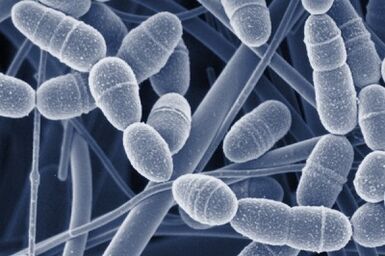
Unlike many pathologies, nail fungi is a slowly developing disease.Its characteristic is a gradual flow that is hard to miss.The treatment of fungi is effective in the early stages, so the sooner it helps, the better.
The initial stage is not usually visually manifested.Therefore, it is impossible to show the appearance of the fungus on the nails on the legs in the initial stage photos.But the first symptom has appeared.Anxiety ringtones related to fungi are violent skin itching, which intensifies throughout the day and reaches maximum intensity at night.The only sign that may be affected by the concept of fungal infection is the appearance of the pathological color of the nails – which is manifested by the development of spots and stripes from light yellow to white shades.There may be dark areas.
The stage of normal nutritional lesions is manifested by moderate symptoms.This fact proves that this fact has not thickened yet, and no significant deformation has been observed in it.However, stains and stripes become extremely visible and visible to others.In addition, the feet can produce unpleasant odors.If you don't start treatment, the disease will inevitably enter the final stage.
Using hypertrophic lesions, not only thickening of the plate itself was observed, but also surrounding tissue.This is manifested by deformation of the nail, which can change the direction of growth, collapse and rupture, and even change from a slight impact on it.As a result, nails can be lowered, while new plates do not grow during severe illness.
In the presence of concomitant pathology, the transition from stage one to launch occurs very quickly in just a few weeks.This may occur due to immune deficiencies, cancer and human weaknesses that occur in old age.
Injections in adults also cause the development of the disease.This may be a direct damage to the nails and surrounding tissues, and the metabolic changes of the nails due to insufficient blood circulation.Currently, ideal conditions are created for fungi.
With obesity and diabetes, nail fungi on the legs appeared in 95 out of 100 cases.This is because fungal microorganisms obtain many necessary for the growth and reproduction of substances, such as glucose and lipids.Therefore, in such patients, pathology is very difficult.
Nail fungus infects skin plants
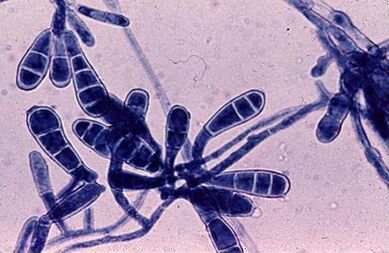
Skin plants are the most common cause of pathology.Infecting them is very simple - through common towels, showers and even indoor slippers.
This fungus has two dangerous representations, and they can also cause fungal lesions - this is the fermented pulbrum and the fermented vegetative hair.
The first represents penetrating the nail plate from its free edge while moving further.The signs of this fungal infection—the color change of pink to yellow nails on the legs, spreading black, and the texture of the plate deteriorates—it becomes fragile and fragile, collapses, and the body is exposed.
For an accurate diagnosis, you need to know what the nail fungus looks like.The most distinctive feature is the disengagement of nails near the edges near the nails.In this space, dirt accumulation occurs, which is conducive to the development of microorganisms.During this time, simply use ointments and creams in parallel with antifungal drugs to eliminate fungi without losing nails.
This is the distal form of the disease, which manifests as the onset of the lesions in the nail bed.This form is much less because in order to penetrate there, microorganisms are necessary for the input gantry - microcracks or other damage.This is not uncommon after an injury.With this option, it is necessary to remove the nail plate completely, as any conservative treatment will be ineffective.
If the cause of the fungus is Trichomonas, then the signs of the disease will be as follows:
- Thickening - The plate will have obvious hypertrophy and deformation and defects of the fabric;
- The plate turns yellow with a honey tone.
- An abscess on the finger near the nails appeared.
- In the later stages, skin lesions can also be connected together - in the interdental space, peeling and cracking of the skin;
- The appearance of white strips and spots develop - these places are where fungi are most intensely parasitic.
- At hand, this type of pathogen will never parasitic.
To get rid of this fungus, it is necessary to provide the correct comprehensive treatment of oral medications and topical therapies - gels and ointments.
In severe cases, you may need to remove nails and laser cleaning to remove microorganisms.There are many positive comments on this approach.Use of varnish is prohibited.
Changes in nail infection with fungi of the genus
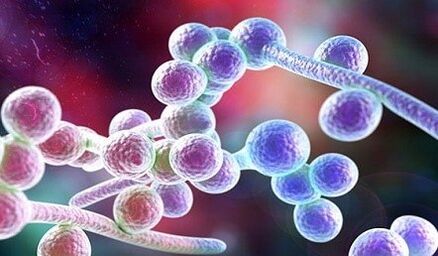
The disease is characterized by damage not only to the tissues of the limbs, but also to the brush positioning.For example, the right hand is the right hand.The disease develops faster due to frequent contact with water.
One characteristic of the disease is the damage to the nails by the box.Over time, more tissue is captured - first the cell division area, then the free edge.
Due to this disease, more than other diseases, secondary infections occur.Candidiasis is accompanied by pain in the roller and bed, and during palpation, serous or suppurative discharge can be secreted.
The nails gradually deform and rise above the skin, and their thickness can reach a few millimeters.At the same time, the nails become waves, which are manifested by the existence of SO scallops that can be in different directions.However, with candidiasis, the most common form of nail damage is precisely the level of darkening.
In severe pathology, the nails gradually separate from the nail bed, accompanied by discomfort and pain.If this nail is accidentally traumatized, it may be accompanied by heavy bleeding.In this case, the wound surface is delayed for a long time.
If the fungus affects the free edge of the nail, it is usually combined with the skin or generalized form.It is called the far end.This variant of the disease process is more difficult and harder to treat.The distal form indicates that human immunity is weakened and affected by microorganisms.
The treatment of candidiasis varies in different forms and stages of the disease.First, you can try to influence microorganisms with the help of local means, but with a broad or rapid form, you need to take systemic oral medications.Furthermore, if there are signs of widespread damage to the fungus, it is necessary to prescribe a complete medical examination to search for diseases that lower immunity levels.
Nails change with mold damage
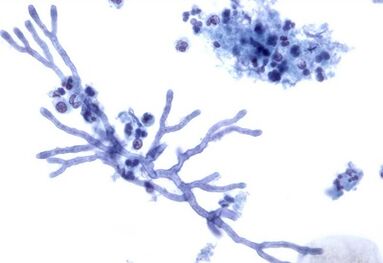
Mold mushrooms are less common than other pathogens.This is due to the fact that a person is in contact with this type of microorganism due to specificity.These mushrooms are usually infected in the context of existing lesions.The favorite colony that molds are added is the hairy plant.In this context, you can often see the combined effect of mushrooms and bacteria.
This disease is a characteristic of the elderly.During this period, a decrease in cellular immunity and a weakening of the body will occur, so the mushrooms are stronger.
One characteristic of these pathogens is their selectivity.They do not affect the skin and soft tissues, and only locally on the nails.
Among causal agents, the most types are:
- Alternatives - This fungus determines the development of nail deformation and excessive excessive deformation.To recover from this disease, it is necessary to remove the nail plates, as the microorganisms are very deep into the tissue and it is difficult to eliminate them.
- Scytalidium dimidiatum - Most of this microorganisms appear in people with diabetes.To get rid of this fungus, it is necessary to carefully monitor glucose levels in the blood and observe in parallel with endocrinologists.
- The Brevicaulis spine is more often found in public places, such as in bathrooms, swimming pools, and showers.When it is in the nail plate, their color changes from pink to white.
- Fusarium is common in rural areas, it is a lot on the ground and it can be easily switched to fabrics.This fungus can cause mycomycosis in the internal organs when it penetrates into the body, which is difficult to treat.Treatment for this terrible disease should be done only in the hospital, as treatment is sufficiently severe for the patient.
The treatment of mold damage is very complicated because it is necessary to treat the body from several microbial colonies.To produce a fairly high-quality therapy, a combination of antibiotics and antifungal drugs is used.In severe cases, they are not taken orally, but are intravenously.















